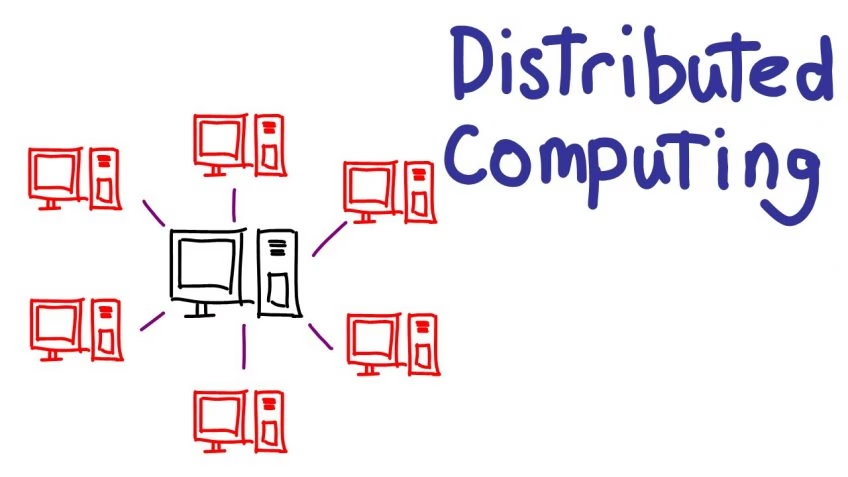
How To Build a Distributed System?
Interested in building a distributed system?
This is an important industry that has great promise for investors.
According to a study done by Industry ARC, "The Distributed Cloud Market is forecast to reach $3.9 billion by 2025, growing at a CAGR of 24.1% during the forecast period from 2020-2025."
Setting the Context: The Era Before Distributed Computing System

Before we delve into building a distributed computer system, let‘s understand the historical context of its emergence. The era before the emergence of distributed computing was dominated by mainframe computers, and IBM Mainframe was the most prominent.
Mainframes were the most important means to process a large amount of data until the mid-1990s. They performed these data-processing tasks centrally, and a central processor would control every peripheral device.
IBM Mainframe gained its market share on the back of the value it offered, e.g.:

Get a complimentary discovery call and a free ballpark estimate for your project
Trusted by 100x of startups and companies like
- It processed transactions at a large scale.
- These mainframe computers easily supported a large number of concurrent users and application programs.
- IBM Mainframe computers handled large distributed databases efficiently.
- Its security, reliability, serviceability, availability, and compatibility were impressive.
Read more about IBM Mainframes in “Who uses mainframes and why do they do it?”.
Why Distributed Computing: The Need for Next-Level Computing Beyond Mainframes
While Mainframes offered many advantages, there were a few drawbacks too, e.g.:
- These computers were expensive, therefore, while large organizations could afford them, small businesses couldn‘t.
- Mainframe computers used specialized software and hardware, and organizations using them had to invest in well-equipped data centers.
- Operating, maintaining, and troubleshooting mainframe computers required specialized skills.
Read more about these drawbacks in “What are the advantages of using a mainframe computer and how secure are mainframe computers?"
As personal computers (PCs) emerged, many people took to computers, and the number of businesses willing to invest in computers increased. Naturally, this gave rise to a larger number of concurrent users online, and computing systems needed to support them. A new paradigm of computing had to be found.
Distributed System: A Practical Definition
Distributed computing is a form of computing that takes a user requirement and divides it into smaller chunks. The computing system then assigns these tasks to multiple machines in the network.
If you design a distributed computer system well, then it functions as one system and not disparate computers. Computers in such a network address their parts of the overall computing requirement, and the system provides one result to the user.
The coordination between the different computers in this network is key to the success of distributed computing. You can read “Distributed computing system” to learn more.

Examples of Distributed Systems
Let‘s see how distributed systems work, and for this, we will review one example. Consider the example of Google Web Server. When Internet users submit a Google search request, they perceive the search engine as one system.
However, Google Web Server is a distributed computing system, and it consists of multiple servers in the background. It assigns the data processing task to a server in an appropriate region, therefore, the user sees the search results without any notable latency.
Other examples of distributed computing systems are The World Wide Web (WWW), Hadoop‘s Distributed File System (HDFS), ATM networks, etc.
Benefits of Distributed Computer Systems
How did distributed computing systems make a difference? They delivered several benefits over their centralized counterparts, e.g.:
- Cost-effective use of hardware: As the workload increases, the utilization of the component computers increases. This naturally delivers a better price/performant ratio.
- Better performance: Distributed computer systems use their many nodes to deliver better cumulative computing power and storage capacity.
- A higher degree of scalability: Distributed computer systems can scale horizontally, therefore, you can incrementally increase the processing power and storage capacity.
- Distribution of tasks: A well-designed distributed computer system will effectively distribute tasks.
- Built-in redundancy: A distributed computer system has several component computers. This improves redundancy and fault tolerance. Therefore, such systems are better cushioned against hardware or software failures.
Read more about this in “Cloud computing vs. distributed computing”.
Building a Distributed Computer Solution
I will now explain the steps required to build a distributed computing solution, and these are as follows:
1. Conduct due diligence
You should first analyze thoroughly whether you should indeed build a distributed computer system to address your requirements. This requires you to first onboard a project manager (PM), an IT architect, and business analysts.
The importance of this due diligence arises from the fact that despite its advantages, a distributed computer system doesn‘t solve every business problem. There are certain disadvantages of using a distributed computer system, and you should consider them during this due diligence exercise.
These disadvantages are as follows:
- Although a distributed computer system results in long-term cost savings, the initial cost of designing and building such a solution is high.
- Building a distributed computer system involves complexities. It‘s hard to conceptualize, design, build, and maintain such systems.
- Businesses deal with sensitive data, and it‘s hard to secure this in a distributed computer system.
2. Zero in on a development methodology
A project to build a distributed computer system is an important one in any organization since it signals a shift in how the organization will manage its IT assets henceforth. Such projects typically have well-defined requirements.
Hire expert developers for your next project
1,200 top developers
us since 2016
If you plan to build such a system in your organization, then prepare for detailed reviews by senior management. Such reviews after key phases will help to mitigate the project delivery risks.
A project like this will benefit from the Waterfall methodology, as I have explained in “What is software development life cycle and what do you plan for?”. You should plan for the following phases:
- Requirements analysis;
- Design;
- Development;
- Testing;
- Deployment.
3. Gather, analyze, and baseline the project requirements
The PM, IT architect, and business analysts need to gather the business requirements from the business stakeholders. They need to analyze the stakeholder inputs, subsequently, they need to create the requirements documentation.
There might be multiple reviews of the requirements documentation. It‘s important to formally baseline the requirements since unclear and fluid requirements pose challenges to software development projects. I explained this challenge earlier in “Machine learning in future software development”.
4. Form a project team
You now need to hire the other team members to staff the following roles:
- A cloud architect;
- An information security architect;
- A data modeler;
- A database administrator (DBA);
- UI designers;
- Web developers with Node.js skills;
- Testers;
- DevOps engineers.
If you are considering hiring freelancers to staff these roles, I recommend hiring a field expert development team instead. A complex project like this requires a field expert development team, as I have explained in “Freelance app development team vs. field expert software development teams”.
5. Choose the right cloud infrastructure provider
Building a distributed computer system is hard enough, therefore, you help yourself as much as you can! One way to help yourself is to find the right managed cloud services provider. This frees you up from the demanding job of IT infrastructure management.
I recommend Amazon Web Services (AWS), which is a leading managed cloud services provider. Its Amazon Elastic Compute Cloud (EC2) is a well-known Infrastructure-as-a-Service (IaaS) offering, and AWS has robust cloud capabilities.
AWS offers several advantages, e.g.:
- You can easily sign up with AWS, and you can use it easily, thanks to its management console.
- Its billing plans are flexible and easy to understand.
- AWS has a global presence and robust infrastructure, which reduces latency and ensures high availability.
- You can scale up easily, moreover, AWS offers a wide range of services.
Read “Advantages of AWS | Disadvantages of AWS Amazon Web Services” for more information.
6. Data modeling and choosing the right databases
The next key step is data modeling, moreover, you need to select the right database solutions for your proposed distributed computer system. Data modeling includes creating the following:
- Conceptual data models;
- Logical data models (LDMs);
- Physical data models (PDMs).
Your business requirements would influence the choice of your database. If you need to use a SQL database, then MySQL is a great choice. MongoDB is a robust choice if you need to use a NoSQL database.
7. Securing your distributed system application
We read about data breaches, identity theft, and exposure to sensitive data almost every day. Many businesses had to pay penalties due to data breaches, moreover, their customers had to contend with the fallouts of such breaches.
Given this, it‘s important to mitigate the key application security risks. There are several such risks, e.g.:
- Injection;
- Ineffective authentication;
- Exposure of sensitive data;
- XML external entities (XXE);
- Incorrect implementation of identity and access management;
- Inadequate security configuration;
- Cross-site scripting (XSS);
- Using outdated software with known vulnerabilities.
Read more about these in “Open Web Application Security Project (OWASP) top 10 application security risks ”.
8. Building APIs and consuming them
Consider building application programming interfaces (APIs) that the clients in the proposed distributed computer system can use. APIs deliver several advantages, e.g.:
- Delivering information and services becomes easier with APIs.
- APIs enable automation, integration, and higher efficiency.
There are two modern ways to design APIs and consume them, namely, REST (Representational State Transfer) and GraphQL (Graph Query Language). You can consider either of the two options, however, it‘s helpful to know the differences.
Hire expert developers for your next project
REST is a significant improvement from earlier API protocols like SOAP, RPC, CORBA, etc. These earlier protocols were quite rigid, therefore, developers couldn‘t implement the required flexibility in how clients and servers communicate.
The RESTful architecture uses HTTP and standard CRUD verbs like GET, PUT, POST, etc., therefore, it allows much more flexibility. It has become the standard in designing and consuming APIs. Read more about it in “REST vs. GraphQL APIs, the good, the bad, the ugly”.
However, everything revolves around the API endpoints in the RESTful architecture. If an application needs only one field from an API endpoint, it still needs to retrieve the entire endpoint. We call it “Over-fetching”.
What if the application needs more data than what the endpoint contains? Well, it needs to make multiple API calls in that case. We call this “Under-fetching”. As APIs and distributed applications consuming APIs grew significantly, this inefficiency made a key impact.
With REST APIs, you need to design your front-end views in line with your API endpoints. If you decide to change the front end, then you will also need to change the back end.
GraphQL addresses these limitations, thanks to its query language. Developers can specify the exact fields they want using GraphQL, therefore, the challenges with over-fetching and under-fetching don‘t arise. The flexibility of GraphQL also removes the tight coupling between the front-end and back-end.
This doesn‘t mean that you can‘t use REST since it‘s still a powerful and popular architecture for APIs. You need to carefully analyze your requirements before making a choice, and you can read more about it in “REST vs. GraphQL”.
9. Manage the caching of a distributed system architecture
Managing the caching well is important for the performance of a distributed computer system. Your IT architect should formulate a good caching strategy, e.g., the application could take advantage of users‘ browser cache.
10. Web app development, testing, and deployment
I recommend that you use Node.js to develop the web app in the proposed distributed computer system. Node.js is a popular open-source runtime environment, and it‘s a great choice for coding scalable and performant web apps.
I have earlier explained its advantages in “10 great tools for Node.Js software development”. You need to use the appropriate DevOps tools for testing the app and deploying it. AWS offers excellent DevOps tools, and you can read about them in “DevOps and AWS”.
Planning To Create a Distributed System?
Building a distributed computer system can be complex. You should develop a system that‘s easy to maintain, moreover, security aspects are crucial. I recommend that you engage a reputed software development company for such projects.
You can read our guide “How to find the best software development company?” to find one.
If you are still looking for experienced software developers to build a distributed computing system that is robust and secure, DevTeam.Space can help you outsource field-expert software developers from its community.
Write to us your initial project requirements, and one of our account managers will get in touch with you to provide further help.
Frequently Asked Questions on a Distributed System
Publish clear guidelines on components, standardize interfaces, and ensure that all new interfaces can be easily integrated.
As computer hardware is not standardized, software must be able to overcome this problem.
The Internet is the biggest and most obvious example of modern distributed systems.


